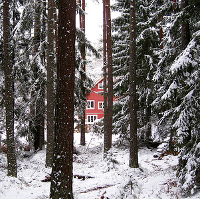24 January 2014
IIASA and Future Forests collaborate on exploring the future of the Swedish forest sector
Researchers from Future Forests and IIASA will collaborate on applying a combination of socioeconomic and biophysical models to the Swedish forest system. The output will show alternative future pathways for the forest land use and for the Swedish forest sector.
“We will be able to identify the tradeoffs and look at various alternatives. Good policy making should always involve looking at the other side of the coin” says Florian Kraxner, deputy program director for ecosystems services and management (ESM) and who is in charge of the project together with Johan Bergh from Future Forests and SLU, the Swedish University of Agricultural Sciences.
IIASA has developed global socioeconomic and biophysical models for land-use change, climate change and markets of wood, bioenergy, agriculture and livestock commodities. A team of scientists from IIASA and Future Forests are going to compare and combine the IIASA models with the Swedish Heureka tool that projects forest development and output of forest products and services. The aim is to explore how alternative Swedish forest management strategies would affect the output of forest ecosystem services and the position of the Swedish forest sector in Europe and globally. Another aim is to look at how the Swedish forest sector may be affected by global trends.
The team consisting of Nicklas Forsell, Georg Kindermann and Eva-Maria Nordström are well into the task of defining the research project in detail.
“We are now in the stage of calibrating and linking the models and building scenarios that are relevant to the Swedish Forests sector”, says Nicklas Forsell who is a modeler, forest ecosystem modeling group leader at IIASA’s ESM Program, and also a former student at SLU. “These scenarios will then be used to illustrate possible future developments and their implications for the Swedish forest sector”.
Florian Kraxner believes many actors in the Swedish forest sector will find results from the project valuable. Recent events in Finland, where the Finnish pulp and paper industry experienced how the demand for products started to decline, illustrates the importance of future outlook studies from a societal as well as industrial perspective.
“A large scale sector needs to be prepared for market changes as well as policy changes. By looking at potential developments of the Swedish market there may be possibilities to anticipate and adapt to such events”, says Florian Kraxner.
In forests that provide a number of ecosystem services it is useful to know where the most critical issues are from the point of view of both society and forest owners. The modeling project may be able to identify hotspots where conflicting demands will be concentrated and suggest options for solutions.
Forestry is a business where decisions have to be made repeatedly in intervals and if you are growing trees it may be very hard to turn around or even change direction. The entire forest product industry, as well as the future provision of other ecosystem services, is depending on decisions made today by forest owners.
Providing the decision makers with better insight into the potential future risks, uncertainties and opportunities is an important task that IIASA and Future Forests have taken on.
Whereas the tradeoffs may be known already to some extent, the modeling results will be a quantitative way to add new information but also to reduce uncertainty in information that is already known.
Putting the Swedish industry in a global context may also be interesting to a larger community. What kind of outside trends can have an effect on the Swedish forest sector, and vice versa. In the face of potential climate change effects, the forestry sector cannot be seen independently from other sectors, especially from agriculture, anymore. In the future, the land use division between forestry and agriculture will probably change and interact more intensively.
“Say for example fast growing tree plantations for bioenergy or biorefinery products, with a turnover of 3-5 years – should that be considered agriculture or forestry?” asks Florian Kraxner. “Nowadays – especially facing potential climate change effects – the forestry sector cannot be seen independently from other sectors anymore. In the future, the land-use division between forestry and agriculture might change and interact more intensively. The Swedish forest sector is an influential actor on the market. What happens to the Swedish industry will have effect on the market, and what the Swedish forest doesn’t produce will be produced somewhere else, either from forests or agricultural land. These indirect land-use changes may affect greenhouse gas emissions, biodiversity as well as food production. ”
This article was originally published on the Swedish University of Agricultural Sciences Web site.
Text by Annika Mossing


